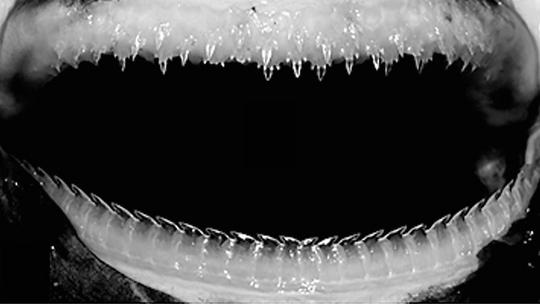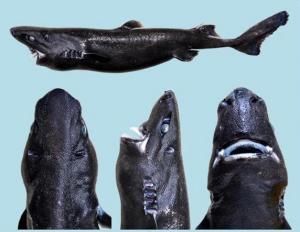The ocean can be a deep and dark place, but the so-called ninja shark can light up its surroundings with a dimly glowing head, according to a new report.
The newly identified species isn't the only glowing shark in the ocean. It joins a group of nearly 40 other species commonly called lanternsharks, which are marine predators with the ability to glow that live in oceans around the world, including the Indian, Atlantic and Pacific oceans, said Vicky Vásquez, lead author of the new report and a graduate student in marine science at the Pacific Shark Research Center in California.
The new report documents the first time a lanternshark has ever been found off the Pacific coast of Central America, Vásquez told Live Science. [In Photos: Spooky Deep-Sea Creatures]
In 2010, researchers observed eight lanternshark species swimming at depths ranging from 0.5 miles to 0.9 miles (0.8 to 1.4 kilometers) under the surface. But the scientists weren't able to analyze all of their observations of the fish right away.
In the new report, the researchers conducted a thorough analysis the traits of the species they observed in 2010, and concluded that the sharks indeed came from a new species of lanternshark. The new species had a uniform dark-black coloring, as opposed to the greys and browns seen on other lanternsharks, Vásquez said.
The newly identified shark also had a different number and distribution of photophores, which are the tiny cup-shaped organs that give lanternsharks the ability to glow. Other lanternsharks have photophores all over their bellies, but the new shark has fewer, and most are concentrated on its head, Vásquez said.
Researchers have yet to see the new shark actually glow, but it likely gives off a blue light, like its lanternshark relatives, she said. Moreover, "we're assuming our shark doesn't glow as brightly" as other species, because it has fewer photophores, Vásquez said.
It's unclear why lanternsharks glow, but it's possible that the glowing photophores on the animals' stomachs mask their shadows, allowing them to "hide" from animals swimming below them. But it could also be that their glowing lights lure prey, such as smaller fish and crustaceans, toward the sharks, or serve as a means of communication, the researchers said.
Revisiting "Jaws"
The researchers named the new species Etmopterus benchleyi, a nod to Peter Benchley, the author of the book "Jaws" and co-author of its 1975 film adaptation.
"Jaws" may have inspired a public fear of sharks, but Benchley worked as a shark advocate in his later years, establishing the Benchley Awards to recognize outstanding achievements in ocean conservation, Vásquez said.
However, Etmopterus benchleyi is a mouthful, so Vásquez enlisted her four young cousins and a group of high school students she mentors to come up with a common name. She is now urging shark enthusiasts to call the newly identified species the "ninja lanternshark."
"They started with 'super ninja,' but I had to scale them back," Vásquez said, laughing.
After talking with her co-authors, she wrote in the report, "The suggested common name, the ninja lanternshark, refers to the uniform black coloration and reduced photophore complement used as concealment in this species, somewhat reminiscent of the typical outfit and stealthy behavior of a Japanese ninja." [Bioluminescent: A Glow in the Dark Gallery]
The newfound species may also remind people that sharks are a varied lot, from the 16-foot-long (4.9 meters) great white sharks (Carcharodon carcharias) in "Jaws" to the small and glowing 1.7-feet-long (0.5 m) ninja lanternsharks, the researchers said.
"When we think of sharks as one type, we're not understanding the true complexity of sharks and the roles they play in the ecosystem," Vásquez said. "They're not all apex predators."
The finding is "cool and elegant" said David Gruber, an associate professor of biology at Baruch College in New York City, who was not involved in the report.
"It redefines our conception of sharks from being these massive fearsome things to these beautiful sometimes small, glowing animals," Gruber said. "It shows us how many more mysteries there to uncover in the shark domain."








